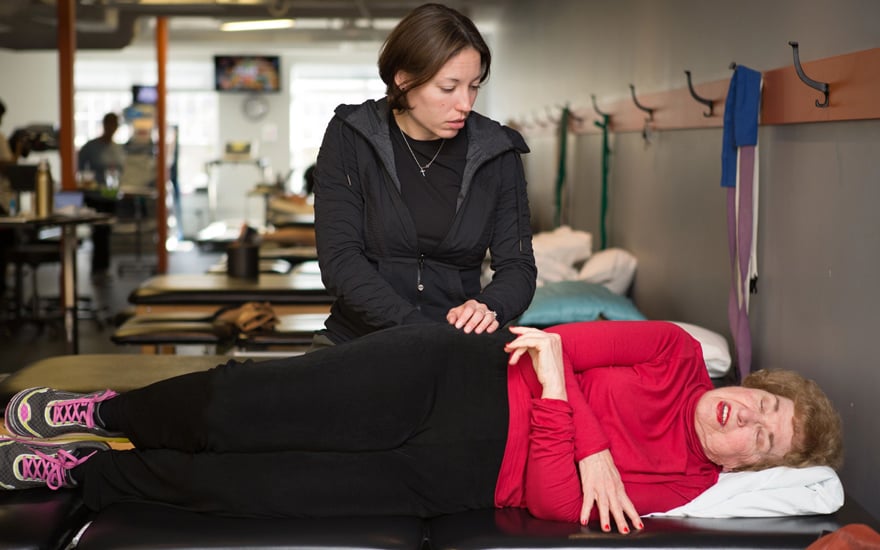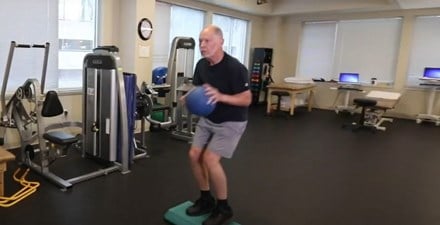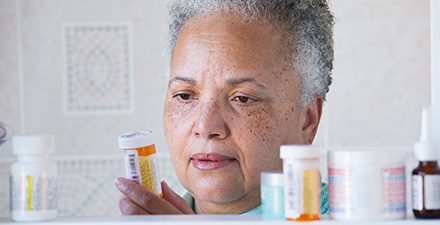Physical Therapy Guide to Hip Osteoarthritis
Hip osteoarthritis, or hip OA, is a health condition involving changes to the cartilage, ligaments, bone, and muscles surrounding the hip joint. It can develop at any age, although it is more common in older adults. Hip OA can make everyday activities, such as walking or climbing stairs, hard to do.
The risk of developing hip OA increases with age. It is more likely to develop in people with a past hip injury or history of hip dysplasia (where the hip socket doesn’t fully cover the ball joint of the thigh bone). Obesity also may increase the risk of developing hip OA.
Physical therapists design treatment programs to help people with hip OA manage pain and return to their regular activities. More advanced cases of hip OA may require hip joint replacement surgery. A physical therapist can help you understand your hip OA and any related problems. They provide treatments to lessen your pain and improve how you move. They also can offer information about healthy life choices to help improve your body weight, nutrition, sleep habits, and level of physical activity.
Physical therapists are movement experts who improve quality of life through hands-on care, patient education, and prescribed movement. You can contact a physical therapist directly for an evaluation. To find a physical therapist in your area, visit Find a PT.
What Is Hip Osteoarthritis?
Osteoarthritis is the most common form of arthritis. It affects all of the tissues surrounding the joints, including cartilage, ligaments, bone, and muscles. OA is diagnosed when injury or inflammation causes the cartilage (soft, shock-absorbing tissue that cushions joint surfaces) to break down. With damaged cartilage, a joint can become painful and swollen.
Hip OA involves a change in the structures of the hip joint. It is more likely to develop later in life. However, it can start earlier if a person has had a previous hip joint injury or hip dysplasia.
Over time, hip OA leads to stiffness, muscle weakness, and increasing pain. These symptoms can make doing daily tasks more difficult and limit your activities. While there is no cure for OA, there are treatments than can reduce pain and improve your ability to participate in activities you enjoy.
How Does It Feel?
Hip OA may cause symptoms such as:
- Pain in the hip joint or groin, which is most common. You also may feel pain in your thigh, knee, or buttocks.
- Stiffness in the hip joint, which is worse after sleeping or sitting.
- Weakness of the muscles in the lower extremity (from your hip to your feet).
- Pain and trouble getting out of bed, standing up from a sitting position, walking, or climbing stairs.
- Difficulty doing normal daily activities, such as putting on socks and shoes.
How Is It Diagnosed?
Hip OA is diagnosed by asking you questions about how your hip feels and examining your hip joint. Imaging (such as X-ray or MRI) is not required to diagnose hip OA. However, your health care provider may order imaging to check for other possible causes of your pain.
Your physical therapist will conduct a full assessment to determine any movement problems related to your hip OA. The process includes taking your medical history and performing a physical exam. They will ask you questions such as:
- When and how often do you feel hip pain?
- How long does the pain last each time?
- Do you have hip joint stiffness, and if so, when?
- What activities are difficult because of your pain and stiffness?
- Did you experience a hip injury in the past?
- Have you been told you have hip dysplasia?
- Do you have pain or stiffness in any other joints?
Your physical therapist will test how your body moves and functions. They may:
- Test your hip range of motion by gently moving your leg in all directions.
- Test your leg strength by asking you to resist as they gently push your leg and hip in different directions (muscle-strength test).
- Test how well your joint moves using hands-on techniques called manual therapy.
- Watch how you walk.
- Ask you to balance while standing (balance test).
- Ask you to sit then stand up from a chair (30-second chair-stand test).
- Watch how you climb stairs and move from one position to another.
- Measure how far you can walk in six minutes.
- Observe how you perform daily activities or relevant tasks that are difficult to do because of your hip pain/stiffness.
Your physical therapist may use other tests to look for problems in other related parts of your body. These can include your lower back, spine, and pelvis. They may recommend that you consult with an orthopedist based on the results of these movement tests.
How Can a Physical Therapist Help?
Your physical therapist will educate you about your condition and help you understand:
- Your treatment options.
- The importance and benefits of regular daily physical activity.
- How to walk, sit, climb stairs, sleep, exercise, and return to activities that you enjoy with less pain.
Your physical therapist will address any specific physical problems related to hip OA. They also may address any problems in surrounding body regions, such as the spine and the lower extremity, to improve overall health and physical function.

The pain of hip OA can be reduced through simple, safe, and effective physical activities like walking, riding a bike, or swimming. However, people with OA often avoid these activities due to:
- Pain and stiffness.
- Confusion about how much and what exercise to do.
- Not knowing when they will see benefits.
Your physical therapist can guide you through a personalized exercise program to help reduce your specific pain and stiffness. The goals of physical therapy and prescribed exercises are to:
- Improve your strength, standing balance, and walking ability.
- Improve your leg, hip, and back motion.
- Teach you how to reduce and self-manage your pain so you can return to work, fitness, and other activities that you enjoy.
Your physical therapy treatment plan may include strategies for:
Pain management. Your physical therapist may use a variety of treatments to control and reduce your pain. Physical therapists are experts in prescribing pain-management techniques that reduce or eliminate the need for medication, including opioids. Your treatments may include:
- Exercises to reduce pain and improve function. Exercise also can help reduce your body weight when needed, further improving pain and function.
- Modifying activities you do throughout the day, so that you experience less pain.
- Hands-on (manual) therapy to improve flexibility and reduce pain before exercise.
- Instruction on when and how to use ice or heat to help manage your pain.
Return to activities. Your physical therapist will design your treatment program to help you return to work, exercise, and other activities in the safest, fastest, and most effective way possible. Working with a physical therapist often can help you reach your goals faster than you are likely to do on your own. They may work with you on job-specific activities or sport-specific drills to help you achieve your goals. Modifying your activities is essential for a safe return to activity. It also helps to control symptoms that may hinder your recovery.
Your physical therapist also may help you determine whether an assistive device, such as a walker or cane, would help. They can teach you how to use these devices if needed.
Structured exercise. Specific exercises will benefit you at each stage of recovery. Your physical therapist will teach you the appropriate exercises at the right times to safely restore your strength, endurance, balance, and agility. These may include:
- Strengthening exercises using:
- Your own body weight as resistance.
- Weights, resistance bands, and weight-lifting equipment.
- Aerobic conditioning using:
- Physical activities you enjoy, such as walking, running, or swimming.
- Cardio (heart) exercise equipment, such as treadmills or stationary bicycles.
- Water exercises if it is too painful to exercise on land.
- Balance exercises, such as standing on one leg or walking over obstacles.
Improving motion. Your physical therapist will choose specific activities and treatments to help restore movement in your leg and hip. These might begin with passive motions that the physical therapist performs for you to gently move your leg and hip joint. They will progress to active exercises and stretches that you do on your own.
If Surgery Is Needed
In some people with more advanced hip OA, pain may make it very hard to exercise and do other activities. For these individuals, hip joint replacement surgery may help. If you are already working with a physical therapist, they may refer you to specialists who can order an X-ray or MRI. While these images alone cannot determine the severity of your OA, your health care providers will consider them alongside your symptoms and physical function to determine whether surgery is appropriate for you. If you decide to have surgery, a physical therapist can help you find an experienced hip surgeon.
Following hip surgery, a physical therapist will visit you daily in the hospital to:
- Help you get out of bed.
- Teach you how to walk and go up and down stairs.
- Instruct you in how to safely use walker or cane.
- Explain any movements you must avoid, to protect your hip as it heals.
- Increase your ability to return home safely.
After you are discharged from the hospital, you may see a physical therapist in the clinic or other setting to continue your rehabilitation. Your physical therapist will work with you after surgery to:
- Help minimize your pain.
- Restore motion and strength.
- Return to your regular activities in the fastest yet safest manner possible.
Can This Injury or Condition Be Prevented?
Not all hip OA can be prevented. However, you can reduce your risk for developing it by maintaining a healthy weight and doing regular physical activity.
You may be able to prevent or slow the worsening of hip OA symptoms by:
- Maintaining strong and flexible hip and leg muscles. You can do this by continuing the exercises you learned during physical therapy.
- Making healthy life choices to improve your body weight, nutrition, sleep habits, and level of physical activity.
- Improving your balance and body mechanics.
- Pacing — spacing out physical activity and tasks throughout the day to reduce hip pain.
- Using an assistive device if appropriate (canes, walkers, braces, specific types of footwear, or orthotics). Your physical therapist can help determine which devices are best for your condition and goals.
What Kind of Physical Therapist Do I Need?
Physical therapists in the United States are prepared through education, clinical training, and experience to treat various conditions such as hip OA. When seeking a provider, you may want to consider:
- A physical therapist who is experienced in working with people with hip OA, or those who have had hip replacement surgery. Some physical therapists have a practice with a geriatric or orthopedic focus.
- A physical therapist who is a board-certified clinical specialist or who completed a residency or fellowship in geriatric or orthopedic physical therapy. This physical therapist has demonstrated advanced knowledge, experience, and skills that may apply to your condition.
You can search for physical therapists in your area who have these and other credentials by using Find a PT, the online tool built by the American Physical Therapy Association.
General tips when you are looking for a physical therapist (or any other health care provider):
- Ask about the physical therapists' experience in helping people with hip OA when you contact a clinic for an appointment.
- Get recommendations from family, friends, or other health care providers.
- Be prepared to describe your symptoms in as much detail as possible.
Other Arthritis Resources
- Community-Based Physical Activity Programs for Arthritis.
- Health center for people with arthritis.
- Physical Therapy Guide to Rheumatoid Arthritis.
The American Physical Therapy Association launched a national campaign to raise awareness about the risks of opioids and the safe alternative of physical therapy for long-term pain management. Learn more at our Safe Pain Management page.
The American Physical Therapy Association believes that consumers should have access to information that can:
- Help them make health care decisions.
- Prepare them for a visit with their health care provider.
The following articles and websites provide some of the best scientific evidence for the treatment of hip osteoarthritis. The articles report recent research and give an overview of the standards of practice both in the United States and internationally. The article titles are linked either to a PubMed* abstract of the article or to the free full text, so that you can read it or print out a copy to bring with you to your health care provider.
National Institute for Health and Care Excellence. Osteoarthritis: care and management. Accessed January 18, 2023. https://www.nice.org.uk/guidance/cg177
Kolasinski SL, Neogi T, Hochberg MC, et al. 2019 American College of Rheumatology/Arthritis Foundation Guideline for the Management of Osteoarthritis of the Hand, Hip, and Knee. Arthritis Rheumatol. 2020;72(2):220–233. Article Summary on PubMed
Ilieva EM. Are exercise interventions beneficial for people with hip and knee osteoarthritis? A Cochrane Review summary with commentary. Musculoskelet Sci Pract. 2019;44:102041. Article Summary on PubMed
Skou ST, Pedersen BK, Abbott JH, et al. Physical activity and exercise therapy benefit more than just symptoms and impairments in people with hip and knee osteoarthritis. J Orthop Sports Phys Ther. 2018;48:439–447. Article Summary on PubMed
Exercise is essential for osteoarthritis: the many benefits of physical activity. J Orthop Sports Phys Ther. 2018;48:448–448. Article Summary on PubMed
Cibulka MT, Bloom NJ, Enseki KR, et al. Hip pain and mobility deficits-hip osteoarthritis: revision 2017. J Orthop Sports Phys Ther. 2017;47:A1–A37. Article Summary on PubMed
Osteoarthritis Research Society International website. Understanding your osteoarthritis. Accessed January 18, 2023. https://oarsi.org/education/patients
Arthritis Foundation website. Hip osteoarthritis. Accessed January 18, 2023. https://www.arthritis.org/search/results?query=hip%20osteoarthritis%20flare%20pain%20management
*PubMed is a free online resource developed by the National Center for Biotechnology Information. PubMed contains millions of citations to biomedical literature, including citations in the National Library of Medicine’s MEDLINE database.
Expert Review:
Sep 23, 2022
Revised:
Jan 23, 2023
Content Type: Guide
Osteoarthritis of the Hip
PT, DPT
Marcie Harris-Hayes
PT, DPT, MSCI
Kenneth L. Miller
PT, DPT, MS, board-certified clinical specialist in geriatric physical therapy, on behalf of the APTA Academy of Geriatric Physical Therapy.
You Might Also Like...
Health Tips
Arthritis: Find a Community-based Physical Activity ProgramJan 16, 2024
Regular physical activity can benefit your physical, mental, and social health, and prevent or improve many chronic conditions. These community-based physical
Video
Physical Therapy Helps Senior Games Athlete Return to the Basketball CourtOct 30, 2019
William is a former Senior U.S. Olympic team athlete who stopped playing basketball due to hip pain. Physical therapy helped to eliminate his pain, and
Did You Know?
Opioids Are No More Effective Than Nonopioids for PainMar 28, 2018
According to a recent study, it appears that opioids may not be any more effective than nonopioid medications, such as nonsteroidal anti-inflammatory drugs


